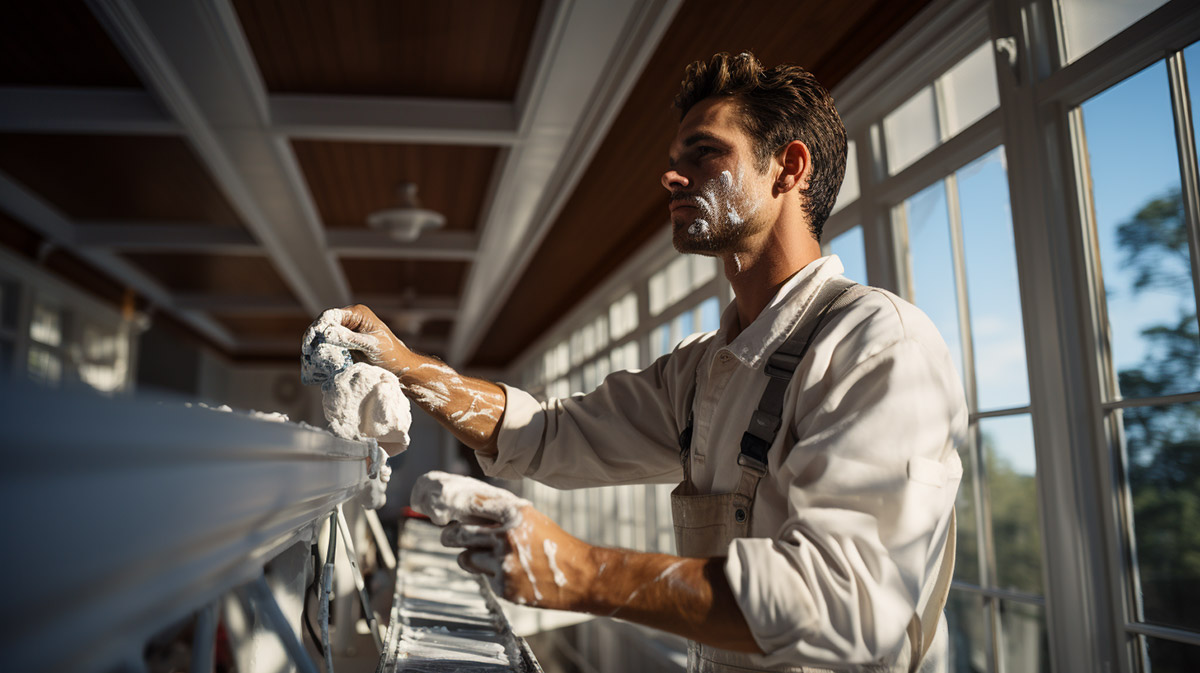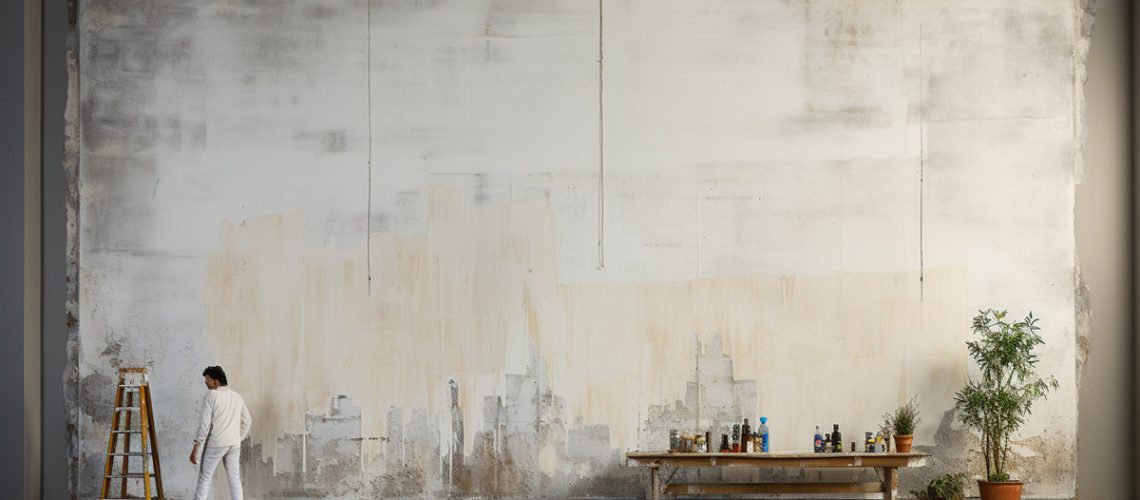Painters wear white because in the 17th century homes were painted white. Wearing “painter’s whites” as they were known, allowed the painters to look clean and not have to worry about colour spots appearing on their clothing.
There are numerous theories and reasons behind this age-old tradition. In this article, we’ll delve into the top 10 reasons why painters don their iconic white attire while ensuring the highest quality results for every room they paint.
1. Historical Roots: The Painter’s Union Influence
Contrary to popular belief, The International Union of Painters and Allied Trades (IUPAT) did not initiate the white attire trend. In fact, painters wore white long before unions existed. The union, however, did enforce the wearing of white, making it a standard across the tradesman profession. They did this to try and set union painters apart from non-union painters.
2. The Impact of Architectural Trends: White Houses and Facades
In the 1700s, many houses, particularly in the southern United States, were painted white to reflect sunlight and keep interiors cooler. This trend extended to both walls and facades. Although this theory doesn’t hold up as a standalone reason for painters wearing white, it undoubtedly played a role in shaping the tradition. This prevalence of white structures was partly due to the practical benefits of the colour. For example, white paint helps to reflect sunlight, keeping homes cooler in hot climates.
During the 18th and 19th centuries, the use of whitewash, a mixture of lime and water, was a popular and affordable method for painting exteriors. Whitewash not only provided a clean, bright appearance, but also served as a protective layer against the elements. The popularity of this method may have contributed to the association between white attire and the painting profession, as painters were often called upon to work on white facades.
As architectural styles evolved over time, the use of white paint expanded to include a wider range of building types, such as colonial, Victorian, and modernist structures. This growth in the prevalence of white buildings further reinforced the connection between white attire and painters, as they were frequently tasked with maintaining and refreshing these iconic white facades.

3. Practicality: Concealing White Dust from Sandpaper and Primer
Historically, painters mixed white lead powder with paint paste to create paint. This process produced white dust that covered everything, including the painters’ clothes.
A key component of any painting project is preparing the surfaces to be painted, which often involves the use of sandpaper and primer. Sanding a surface creates a significant amount of fine white dust, which can easily cling to clothing, tools, and skin. This white dust, particularly when combined with the dust generated from mixing and applying white primer, can create a messy appearance for painters if they were to wear darker or more colourful clothing.
By choosing to wear white uniforms, painters can effectively camouflage the dust generated during the preparation process. This not only maintains a cleaner and more professional appearance but also reduces the frequency with which painters need to launder or replace their work attire.
4. The Perception of Cleanliness: White as a Symbol in the Painting Business
White is often associated with cleanliness, making it an ideal colour for painters who work in the finishing stages of construction. As a result, their attire conveys a sense of order and professionalism, which is crucial to their clients’ perception and the overall success of their painting business. In fact, white has been a symbol of cleanliness in Western culture for a long time, for example, Brides still wear white to represent their innocence as part of a marriage ceremony. Within Australia, white is the most popular car colour due to its high visibility and cleanliness. In fact, Youi Insurance list white as one of the safest car colours.
5. The Testimony of Experience: Worn Whites Tell a Story
A painter’s white uniform tells the story of their experience, whether they are painting a window, a room, or a facade. In the past, dingy whites signified seasoned professionals, while bright whites indicated novices. Today, layers of paint on a painter’s attire serve as badges of honour, showcasing their skills and expertise with various tools and techniques.
6. A Practical Solution: White Is an Affordable Option for Tradesmen
White clothing is often cheaper to produce, as it requires no additional dyeing. Painters, like many other tradesmen working with wood and other materials, look for cost-effective clothing options that are functional and easily replaceable, making white an ideal choice. This practical choice allows painters to invest in multiple sets of clothing to maintain a professional appearance and ensure they always have a clean uniform ready for their next project.
In today’s market, the cost of painter’s uniforms can vary depending on the brand, quality, and design. For example, Bisley Workwear, a well-known paint brand, offers a range of painter’s clothing options, from budget-friendly options to more premium choices. Other brands, such as MASCOT®, also cater to professional painters with a selection of white overalls and coveralls at various price points.
Moreover, the affordability of white uniforms extends beyond painters to other tradesmen as well. Carpenters, plasterers, and other professionals who work in construction or maintenance industries can also benefit from the cost savings of choosing white attire.

7. Comfort Matters: White Keeps Painters Cool during Projects
Painting a home in the Sydney heat, particularly during a hot Australian summer, is no small feat, especially when wearing multiple layers. White clothing reflects sunlight, providing a cooler option for painters who spend hours working outdoors on various projects, such as painting facades or applying wood finishing.
8. A Subconscious Reminder: White Signifies Caution around Adhesive Tape and Tools
When people see a painter wearing white, they subconsciously recognize the need for caution. It serves as a reminder to be mindful of wet paint, open buckets, adhesive tape, and precarious ladders, ensuring everyone’s safety on the job site.
9. A Sense of Professionalism: Uniformity Among Painters and Tradesmen
Over time, wearing white became the unspoken uniform of painters and other tradesmen. This sense of uniformity transcends union membership, creating a professional identity shared by painters everywhere, whether they work with Dulux products or specialize in wood finishing.
10. The Power of Tradition: White Is What Painters Wear
At its core, the tradition of wearing white has persisted for generations, creating a sense of continuity and identity within the painting profession. Although the exact origin of this tradition may be unclear, it has become an enduring symbol of what it means to be a painter, regardless of the specific techniques, tools, or materials they use.
Bonus: Related Professions that Wear White
It’s worth noting that painters aren’t the only professionals who wear white. Chefs, doctors, and nurses have all donned white uniforms throughout history. The reasons behind this choice are similar to those of painters, including cleanliness, professionalism, and tradition.
Importance of Proper Tools and Techniques in Painting
While the colour of a painter’s attire is iconic, it’s the quality of their work that truly matters. This is why it’s essential for painters to have the right brushes, tools and techniques at their disposal. Whether choosing the correct sandable primer for a project, selecting the best adhesive tape to protect a window frame, or using sandpaper to smooth out wood surfaces, professional painters rely on their skills and expertise to deliver outstanding results no matter what room of the house they are working on. Here at Dupaint we use and recommend Dulux or Taubmans paints due to their excellent wear and tear, particularly in your kitchen, bathroom and on drywall and plaster.
In Conclusion: The Timeless Tradition of Painters Wearing White
The tradition of painters wearing white is a fascinating aspect of the profession, with roots that extend far back in history. Although the reasons behind this choice vary, it has become a symbol of professionalism, cleanliness, and identity for painters and other tradesmen alike. As painters continue to hone their craft, using the right tools and techniques to ensure quality work, the white uniform remains a constant, reminding us of the artistry and dedication that goes into every painting project.

